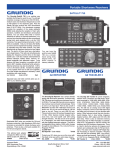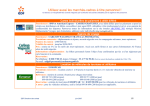Download Sangean ProTravel PT-80 Technical data
Transcript
PT-80 GB Version 1 02 Yacht Boy 80, GB ENGLISH 19.08.2003 14:52 Uhr Seite 21 SAFETY, INFORMATION _____________________ Safety To ensure that this device provides you with long-term satisfaction and enjoyment, please observe the following instructions. This device is designed for the playback of audio signals. Any other use is expressly prohibited. ! VICE ! SER TUNE / SSB MODE ON/OFF SW PAGE DISPLAY SLEEP CLOCK 1/2 MEMO AM/PM SW SELECT 2 3 4 5 6 7 8 C 0 M. DEL M. SCAN ALARM BAND LOCK 9 FREQ. / CLOCK TUNING FINE When deciding where to place the device, please note that furniture surfaces are covered by various types of varnish and plastic, most of which contain chemical additives. These additives can corrode the device supports, leaving residues on the furniture surfaces which can be difficult or impossible to remove. Do not use any cleaning agent, as this may damage the casing. Clean the device with a clean, moist leather cloth. Never open the device casing. Warranty claims are excluded for damage resulting from improper handling. The type plate is located on the bottom of the device. Attention Continuous use of earphones at high volume can damage the user’s hearing. Environmental note As little material as possible was used in the packaging of your device. It consists of two separate materials: cardboard (box) and polyethylene (bag). Please observe the local regulations for disposing of the packing material. Scope of delivery 1 ProTravel 80 2 Earphones 3 External SW antenna 4 Leather bag 5 Operating manual Note: If the radio is fastened to the leather bag, you can use the bag to stand it. Undo the bag at the front and fold it back. Then stand the radio at an angle. ENGLISH 1 • TUNING L OC K LIGHT Protect the device from moisture (water drops or splashes). Do not place any vessels such as vases on the device. These may be knocked over and spill fluid on the electrical components, thus presenting a safety risk. Do not place any objects such as burning candles on the device. 1 02 Yacht Boy 80, GB 19.08.2003 14:52 Uhr OVERVIEW Seite 22 ___________________________________________ Controls LIGHT LIGHT TUNE / SSB MODE ON/OFF SW PAGE DISPLAY TUNE / SSB MODE SLEEP ON/OFF SLEEP SW PAGE DISPLAY CLOCK 1/2 MEMO CLOCK 1/2 MEMO 2 3 4 5 6 7 8 9 C 0 M. DEL M. SCAN FREQ. / CLOCK AM/PM SW SELECT ALARM ALARM BAND LOCK • TUNING L OC K 1 TUNING FINE 1 2 3 4 5 6 7 8 9 C 0 M. DEL M. SCAN FREQ. / CLOCK BAND LOCK • TUNING L OC K AM/PM SW SELECT TUNING FINE Front ON/OFF SLEEP Switches the device on and off. For setting the sleep timer. DISPLAY Switches the display between the frequency and time while the radio is on. ALARM Selects the signal tone alarm. ALARM Selects the radio alarm. LOCK Disables and enables the buttons. TUNING FINE Control dial for fine tuning to radio stations. TUNING LOCK Disables and enables the »TUNING FINE« dial. ľı 2 For setting the time. Press briefly to change the frequency in steps. Hold down to change the frequency quickly up or down. MODE For setting various function modes, such as 12 or 24 hour clock format. SW PAGE CLOCK 1/2 Switches between the first and second memory levels in short wave. Switches the clock between local time 1 and local time 2, for example summer and winter time. MEMO AM/PM Activates the memory function and stores settings. Switches between AM and PM in 12-hour clock format. SW SELECT Selects short wave frequency bands. BAND Switches between the FM (VHF), SW (short wave), MW (medium wave) and LW (long wave) frequency bands. 02 Yacht Boy 80, GB 19.08.2003 14:52 Uhr Seite 23 OVERVIEW ____________________________________ TUNE / SSB MODE ON/OFF SW PAGE DISPLAY 9 0 M. SCAN FREQ. / CLOCK TUNING FINE DC 6V C M. DEL LOCK 1 ... 9 Numerical buttons for various entries. Select stored radio stations. C M. DEL Deletes incorrect entries and preset stations. Switches off the alarm. 0 M. SCAN Numerical button for various entries. Selects stored radio stations in sequence (memory scan). Activates frequency and time settings. FREQ./CLOCK LIGHT Switches on the back light of the display. TUNE/SSB LED lights up green when tuning to radio stations. Lights up red when searching for an SSB (Single Side Band) station on short wave. Lights up orange when receiving an SSB station. • Right side of device For fine-tuning SSB stations on short wave. SSB FINE TUNING SSB ON/OFF Switches the SSB function on and off. TONE LOW HIGH VOLUME | For setting the tone. Adjusts the volume. Left side of device SW EXT. ANT. Connection socket for an external SW antenna. DX./LO. Switches between short-range and long-range reception. STEREO/ MONO Switches between stereo and mono reception. ENGLISH 6 8 SSB OFF ON 5 7 TONE LOW HIGH 4 ALARM BAND VOLUME 3 STEREO/MONO 2 DX. / LQ. AM/PM SW SELECT 1 SW EXT. ANT. SSB FINE TUNING SLEEP CLOCK 1/2 MEMO • TUNING L OC K LIGHT 3 02 Yacht Boy 80, GB 19.08.2003 14:52 Uhr Seite 24 OVERVIEW ____________________________________ CLOCK 1/2 MEMO ANTENNA LIGHT AM/PM SW SELECT 2 3 4 5 6 7 8 9 C 0 M. DEL M. SCAN FREQ. / CLOCK ALARM BAND LOCK • TUNING L OC K 1 TUNING FINE TUNE / SSB MODE ON/OFF SW PAGE DISPLAY SLEEP CLOCK 1/2 MEMO AM/PM SW SELECT 1 2 3 4 5 6 ALARM RESET BAND LOCK 0 Earphone socket (3.5 mm stereo socket). Automatically switches off the loudspeaker. DC 6 V Connection socket for mains adapter (not supplied), input voltage 6 V (200 mA). Ó Top of device ANTENNA Telescopic antenna for FM and SW reception. Bottom of device RESET Returns the device to its original setting. Back of device Battery compartment Map of world time zones Frequency scale 4 02 Yacht Boy 80, GB 19.08.2003 14:52 Uhr Seite 25 OVERVIEW ____________________________________ The display 00:0.0 BROADCAST BAND M 1 M 2 00:,0.00 1 2 3 4 5 6 7 8 The radio alarm function is activated STEP m MHz kHz 9 The signal alarm function is activated The key lock is activated The sleep timer is activated A stereo FM station is being received BROADCAST BAND A regular SW (short wave) band is set Local time 1 is displayed Local time 2 is displayed SW Displays the SW (short wave) waveband FM Displays the FM (VHF) waveband MW Displays the MW (medium wave) waveband LW Displays the LW (long wave) waveband AM Displays the first half of the day in 12-hour format PM Displays the second half of the day in 12-hour format M 1 M 2 Display memory levels 1 and 2 Preset position displays Flashes when the batteries are low kHz Frequency display for MW, LW and SW MHz Frequency display for FM m SW frequency band display STEP Displays the increments in which the frequency is changed ENGLISH SW FM MW AM LW PM Frequency, time, alarm time or sleep timer display 5 19.08.2003 02 Yacht Boy 80, GB 14:52 Uhr Seite 26 POWER SUPPLY ___________________________________ Battery operation 1 Open the battery compartment on the back of the device by pressing the marking and opening the lid. 2 Insert the batteries (4 x 1.5 V, Mignon type LR6/AM3/AA). Notes: When the batteries are low, » « flashes in the display. Each time you switch off the radio, the battery charge indicator, for example »3«, appears for seven seconds. If the charge level falls below »2«, you must change the batteries. Put in the new batteries within 3 minutes, otherwise all stored settings will be lost. Take out the batteries when you know that the device will not be used for a long period of time. The manufacturer accepts no liability for damage resulting from used batteries. Environmental note: Batteries, including those which contain no heavy metal, may not be disposed of with household waste. Please dispose of used batteries in an environmentally sound manner. Find out about the legal regulations which apply in your area. Mains operation (with standard 6 V/200 mA mains adapter) Check if the mains voltage on the mains adapter type plate corresponds to your local mains supply. The only way to disconnect the device from the mains supply is to unplug the adapter. SW EXT. ANT. STEREO/MONO DC 6V 6 1 Plug the mains adapter cable into the »DC 6 V left of the device. 2 Insert the mains adapter plug in the socket. – The batteries in the compartment are switched off. DX. / LQ. DC IN 6V « socket on the Ó 19.08.2003 14:52 Uhr Seite 27 SETTINGS __________________________ Setting the clock Due to the earth’s rotation, places to the west of you are behind you in time, and places to the east are ahead of you. Therefore, the earth is divided into 24 hourly time zones. This system is based on a standard time zone called UTC (Universal Time Coordinated), previously known as GMT (Greenwich Mean Time). Short wave stations always give the time according to UTC. Before you set the clock, find out your local time zone. You can set two different local times. Local time 1 is the time where you live. If, for example, you travel to Hong Kong, you can set the time there as local time 2. The setting for local time 1 is retained. Setting local time 1 When you first switch on the device, or if it has been without a power supply for a lengthy period, »0: 00« and » « for local time 1 appear in the display to indicate that the clock has to be set. 1 With the device switched off, keep pressing » FREQ./CLOCK« until »–: ––« appears in the display and » « flashes. Note: If the radio is switched off, press »DISPLAY« to switch the display to the clock, and start at step 1. 2 Enter the time using the numerical buttons »1 … 0« in the correct sequence, for example »12: 30«. Note: if you enter the digits incorrectly, a signal sounds and »Err« flashes briefly in the display. You then have to start again. 3 Press » FREQ./CLOCK« to confirm the entry. Setting local time 2 1 With the device switched off, press »SW PAGE CLOCK 1/2«. – Display: » « flashes for local time 2. 2 Press » FREQ./CLOCK«. – Display: » « stays lit for local time 2. – The display is now set to local time 2. 3 To set local time 2, do the same as for local time 1 (steps 1 to 3). Note: If you are operating the device in the 12-hour format, you can choose between »MEMO AM/PM« AM and PM. ENGLISH 02 Yacht Boy 80, GB 7 02 Yacht Boy 80, GB 19.08.2003 14:52 Uhr Seite 28 SETTINGS ___________________________________________________ Setting and storing radio stations There are various ways to set radio stations and store them at preset positions. 1 Press »ON/OFF SLEEP« to switch on the device. – You will hear the radio station last selected. 2 Press »BAND« to select the frequency band. Tuning radio stations directly 1 Press » FREQ./CLOCK«. – Display: »– –.– –«, e.g. » FM « and »MHz« flash. 2 Enter the frequency using the numerical buttons »1 … 0« in four digits, for example 1, 0, 0, 6 for »100.60«. 3 Press » FREQ./CLOCK« to confirm the entry. – Display: the frequency you entered, for example »100.60«. – You will hear the selected radio station. Tuning radio stations manually (1) 1 Use the »TUNING FINE« dial to tune to the station you want. – Display: the frequency in 100 or 200 kHz increments (FM), in 9 or 10 kHz increments (MW), in 3 kHz increments (LW) or in 5 kHz increments (SW). 2 If you want, you can fine tune to the station by briefly pushing in and turning the »TUNING FINE« dial. – Display: The frequency changes in 50 kHz increments (FM) or 1 kHz increments (MW, LW and SW). 3 To return to the original mode (for example 100 kHz increments in the FM band) push in the »TUNING FINE« dial again. Tuning radio stations manually (2) 1 Keep pressing »ľ« or »ı« until you reach the frequency you want. – Display: the frequency changes in increments or Hold down »ľ« or »ı« until the frequency changes to a rapid runthrough. – Display: the automatic search stops at the next station with a strong signal. Saving radio stations on preset positions You can store up to 45 radio stations, including 18 on two memory levels on short wave, and nine each on FM, MW and LW. 1 8 Select the frequency band and the radio station. 19.08.2003 14:52 Uhr Seite 29 SETTINGS ___________________________________________________ 2 3 Press »MEMO AM/PM«. – Display: » M 1 « and the preset number, for example » « flash. Press » FREQ./CLOCK« to store the radio station. – Display: the frequency and » «. – The current radio station is stored on preset position 1. Storing short wave (SW) stations The short wave band is divided into frequency bands of different lengths. This means that very many stations and institutions use this wave band for international communication. Therefore, you can store up to 18 SW stations on two memory levels. 1 Save short wave stations in the same way as described in the previous section. 2 Once you have stored nine stations on one memory level » M 1 «, press »SW PAGE CLOCK 1/2« to switch to the second memory level. – Display: » M 2 «. 3 Store the remaining nine stations as described above. Note: If you try to store more than 18 stations and press »MEMO AM/PM«, »FULL« appears in the display. Automatic station search This function allows you to automatically search for and store nine stations in each of the FM, MW and LW bands (not SW). 1 To start the search, press »ľ« and »ı« at the same time and hold them down until you hear a signal. – The search starts at the lowest frequency in the selected wave band, and stores the nine stations with the strongest signals. After the search has finished, a signal sounds and the last station stored can be heard. – Display: » M 1 « and the preset number, for example » «. Notes: When you start the search, all the previously stored stations are deleted. During the search, the status line » ... ... ...« shows the progress, but not the stations found. You can stop the search by pressing »ON/OFF«. You can reorganise the preset stations using MODE 50 or 51 (see page 16). ENGLISH 02 Yacht Boy 80, GB 9 02 Yacht Boy 80, GB 19.08.2003 14:52 Uhr Seite 30 SETTINGS ___________________________________________________ Deleting preset stations 1 Enter the preset station using the numerical buttons » 1 … 9«. – Display: the frequency and the preset number, for example » 2 Press »MEMO AM/PM«. – Display: The selected preset station flashes. 3 Press »C M. DEL«. – The selected preset station is deleted. «. Setting the alarm time The alarm time is always set in the time shown on the display. You can set the alarm as a signal tone, a radio station, or both. 1 Press »ALARM « (signal tone) or »ALARM « (radio station) with the device switched off. – Display: the alarm time most recently set, » « or » « flash. Note: If the radio is switched off, press »DISPLAY« to switch the display to the clock, and start at step 1. 10 2 Enter the alarm time using the numerical buttons » 1 … 0«. 3 Press » FREQ./CLOCK« to confirm the entry. – Display: the alarm time you entered, » « or » « stay lit. – The device switches on at the set time with the signal tone or the radio station most recently selected. 19.08.2003 14:52 Uhr Seite 31 OPERATION __________________________________________ Switching on and off 1 Press »ON/OFF SLEEP« to switch on the device. – You will hear the radio station last selected. 2 Press »ON/OFF SLEEP« to switch off the device. – Display: Local time 1 or 2. Radio operation Selecting the frequency band 1 Select the desired waveband (FM, SW, MW or LW) by pressing »BAND«. 2 If you select short wave, you can select the frequency band by pressing »SW SELECT«. – Display: the SW frequency bands from »120 m« to »11 m«. Calling up stored radio stations 1 Select the station using the numerical buttons » 1 … 9« for the preset number. – Display: the frequency and the preset number, for example » «. 2 To call up preset numbers 10 to 18 in the SW band, press »SW PAGE CLOCK 1/2« to switch to the second memory level. – Display: » M 2 «. Notes: For FM reception pull out the telescopic antenna and tilt it until you receive the best signal. For short wave reception (SW) the antenna should be upright. For medium wave and long wave reception, align the antenna by turning the device. Checking stored radio stations You can call up all the stored radio stations in a wave band automatically for seven seconds (memory scan). 1 With the radio playing, press »0 M. SCAN«. – The device starts with the current preset station and soon changes to the next one. – When you reach the station you want, press »0 M. SCAN« to stop the function. Swapping preset positions 1 Enter the preset station to swap using the numerical buttons »1 … 9«. 2 Press »MEMO AM/PM«. – Display: the selected preset position flashes. 3 Enter the new preset position using the numerical buttons » 1 … 9«. – A signal sounds and the preset positions are exchanged. ENGLISH 02 Yacht Boy 80, GB 11 02 Yacht Boy 80, GB 19.08.2003 14:52 Uhr OPERATION Seite 32 _______________________________________________ Adjusting the volume 1 Adjust the volume using »VOLUME device). |« (on the right side of the Adjusting the tone 1 Adjust the tone using »TONE LOW HIGH« (on the right side of the device). Listening with earphones 1 Insert the earphone plug (ø 3.5 mm, stereo) into the »0« jack on the left of the device. – This automatically switches off the loudspeakers. Switching between stereo and mono reception FM stereo reception is only available with earphones. 1 Connect the earphones and select an FM station. 2 Set the »MONO/STEREO« switch (on the left of the device) to stereo. – Display: » «. 3 If the reception of the station is weak in FM stereo, move the »MONO/STEREO« switch (on the left of the device) to mono. – Display: » « disappears from the display. Setting the reception sensitivity 1 Set the »DX./LO.« switch (on the left of the device) to »DX.«. – The sensitivity is set to high, in other words, long-range reception. 2 If the signal is too strong, and is causing distortion, move the »DX./ LO.« switch to »LO.« (low sensitivity). Special features of SW reception Short wave reception Your radio can receive signals in a number of frequency bands. It is easy to get used to tuning to stations in the FM, MW and LW bands, since they are always on the same frequencies. Unfortunately, this is not always the case with short wave stations. Due to atmospheric conditions, short wave stations must frequently broadcast on different wavelengths. Most short wave bands are available all over the world and can be used by international broadcasters. At present these are the only wavelengths which provide listeners with direct reception over long distances. For this reason, short wave frequencies are not only used by radio stations, but also by other users such as amateur radio enthusiasts, shipping, aircraft and radio navigation systems. 12 19.08.2003 14:52 Uhr OPERATION Seite 33 _______________________________________________ If you want to listen to a particular SW station, you need to know the precise frequency and wavelength. Many short wave stations will send you broadcasting schedules which give you the information you need. You can also download the information from the Internet. Connecting the external SW antenna To improve short wave reception, you can connect the external SW antenna supplied. 1 Insert the plug of the antenna cable into the »SW EXT. ANT.« socket on the left of the device. Note: Unroll and align the antenna to achieve the best reception. If there is interference, you can move the »DX./LO.« switch to »LO.«. SSB reception (for example for radio hams and shipping) Some short wave stations broadcast Morse code for shipping using continuous waves (CW). Voice signals, for example amateur radio, is normally broadcast on the single side band (SSB). 1 Select the SW waveband using »BAND«. 2 Select the frequency band, for example »75 m«, using »SW SELECT«. 3 Set the »SSB ON OFF« switch (on the right of the device) to »ON«. « LED lights up red and then goes out. – The »TUNE/SSB 4 Slowly turn the »SSB FINE TUNING« dial on the right of the device until you achieve a clear reception. « LED lights up – If an SSB station is received, the »TUNE/SSB orange. • • Notes: For fine tuning, you can also press in the »TUNING FINE« dial. The range for SSB fine tuning is around ± 1.5 kHz. ENGLISH 02 Yacht Boy 80, GB 13 02 Yacht Boy 80, GB 19.08.2003 14:52 Uhr OPERATION Seite 34 _______________________________________________ Alarm mode Displaying the alarm time 1 Press »ALARM « or »ALARM «. – Display: briefly, the alarm time most recently set, » flash. « or » « Alarm with signal tone 1 With the device switched off, press »ALARM « (signal tone). – Display: the last alarm time set, » « flashes. 2 Enter the alarm time using the numerical buttons »1 … 0«. 3 Press » FREQ./CLOCK« to confirm the entry. – Display: the alarm time you entered, » « stays lit. – The device switches on with the signal tone at the set time (alarm duration 1 hour). The signal tone increases in volume for one minute, stops for a minute and starts again. Alarm with radio station 1 Press »ON/OFF SLEEP« to switch on the device. 2 Select the frequency band and the radio station. 3 Adjust the alarm volume using »VOLUME device). 4 Press »DISPLAY« to switch the display to the clock. 5 Press »ALARM « (radio station). – Display: the last alarm time set, » « flashes. 6 Enter the alarm time using the numerical buttons »1 … 0«. 7 Press » FREQ./CLOCK« to confirm the entry. – Display: the alarm time you entered, » « stays lit. 8 Press »ON/OFF SLEEP« to switch off the device. – The device switches the radio on at the set time (alarm duration 1 hour). |« (on the right of the Cancelling the alarm for the day 1 Press »ON/OFF SLEEP« while the alarm is sounding. – The alarm (signal tone or radio) stops, but the alarm function remains activated for the next day at the set time. Cancelling alarm stand-by 14 1 Press »ALARM « or »ALARM «. – Display: the set alarm time, » « or » 2 To deactivate the alarm, press »C M. DEL«. – Display: the alarm time and » « or » « go out, and you can see the current time. « flash. 19.08.2003 14:52 Uhr OPERATION Seite 35 _______________________________________________ Sleep timer mode The device has a sleep-timer, which switches it off at a time you set. Setting the sleep timer 1 With the radio playing, press and hold down »ON/OFF SLEEP«. – Display: the sleep times »60«, »30«, »15«, »120«, »90« and again »60«, » « flashes. 2 To set the desired switch-off time, release »ON/OFF SLEEP«. – Display: after a pause, the frequency, » « stays lit. Deactivating the sleep timer 1 To deactivate the sleep timer, press »ON/OFF SLEEP« to switch off the device. – Display: the time, » « goes out. Additional functions Displaying local time 1 or 2 If you have set two local times, local time 1 (» «) is normally displayed. 1 To temporarily change from local time 1 to local time 2, press »SW PAGE CLOCK 1/2«. – Display: Local time 2 and » «. – After seven seconds the display returns to local time 1. 2 To permanently change from local time 1 to local time 2, press »SW PAGE CLOCK 1/2« and then » FREQ./CLOCK«. – Display: Local time 2 and » «. 3 To permanently change from local time 2 to local time 1, press »SW PAGE CLOCK 1/2« and then » FREQ./CLOCK«. – Display: Local time 1 and » «. ENGLISH 02 Yacht Boy 80, GB 15 02 Yacht Boy 80, GB 19.08.2003 14:52 Uhr OPERATION Seite 36 _______________________________________________ Setting various function modes Using the »MODE« button and a two-digit code, which you enter using the numerical keys »0 ... 9«, you can change various functions: Code Function Code Function MODE ˯ 10 FM frequency change 11 in 100 kHz steps FM frequency change in 200 kHz steps MODE ˯ 20 MW frequency change 21 in 9 kHz steps MW frequency change in 10 kHz steps MODE ˯ 30 Time display in 12 hour format 31 Time display in 24 hour format MODE ˯ 40 Signal tone off 41 Signal tone on MODE ˯ 50 Arrange stations in sequence from low to high frequency range 51 Arrange stations in sequence from low to high frequency range This is how to change the various function modes: 1 Press »MODE«. – Display: »( )« flashes. 2 Enter the code, for example »40«, using »0 ... 9«. – Display: »( 40 )« flashes. 3 Press » FREQ./CLOCK« to confirm. – Display: briefly »OFF«, then the time or frequency. – The signal tone is deactivated. Switching on the back lighting for the display 1 Press »LIGHT« to switch on the display lighting for 7 seconds. 2 Press »LIGHT« to switch off the display lighting. Disabling and enabling the buttons 16 1 To disable the buttons, move »LOCK« to the »•« position. – Display: » «. 2 To enable the buttons, move »LOCK« to the opposite position. – Display: » « disappears from the display. 19.08.2003 14:52 Uhr OPERATION Seite 37 _______________________________________________ Disabling and enabling the fine tuning dial In order to prevent the frequency being changed accidentally, you can disable the »TUNING FINE« dial. 1 To disable the dial, move »TUNING LOCK« to the »•« position. 2 To enable the dial, move »TUNING LOCK« to the opposite position. Deleting all settings You can reset the device to its original state. All settings are lost when you do this. 1 Press »RESET« on the bottom of the device using a suitable implement such as a paper clip. – The times, alarm time and radio settings are deleted. ENGLISH 02 Yacht Boy 80, GB 17 02 Yacht Boy 80, GB 19.08.2003 14:52 Uhr Seite 38 INFORMATION_____________________________________ This device is noise-suppressed according to the applicable EU directives. This product fulfils the European directives 89/336/EEC, 73/23/EEC and 93/68/EEC. This device conforms to the safety regulation DIN EN 60065 (VDE 0860) and therefore the international safety regulation IEC 60065. Technical data Power supply Battery operation Mains operation 4 x 1.5 V (type Mignon LR 6/AM 3/AA) 6 V (200 mA) mains adapter, DC Output 300 mW 10% THD Antennas Telescopic antenna Ferrite rod antenna FM (VHF) and SW (short wave) MW (long wave) and LW (medium wave) Frequency bands FM (VHF) 87.5 ... 108 MHz MW (medium wave) 520 ... 1710 kHz or 522 ... 1710 kHz LW (long wave) 153 ... 283 kHz SW 1 ... 14 (short wave) 120 90 75 60 49 41 31 25 21 19 16 15 13 11 Sockets DC socket Earphone jack SW antenna socket m m m m m m m m m m m m m m 2.3 ... 2.495 MHz 3.2 ... 3.4 MHz 3.85 ... 4.0 MHz 4.75 ...5.06 MHz 5.9 ... 6.2 MHz 7.1 ... 7.35 MHz 9.4 ... 9.99 MHz 11.6 ... 12.1 MHz 13.5 ... 13.87 MHz 15.1 ... 15.8 MHz 17.48 ... 17.9 MHz 18.9 ... 19.02 MHz 21.45 ... 21.75 MHz 25.6 ... 26.1 MHz Ø 4.0 mm, 6 V (200 mA) Ø 3.5 mm stereo, 2 x 32 Ω impedance Ø 3.5 mm Mono Dimensions and weight WxHxD Weight 184 mm x 120 mm x 40 mm 510 g Technical and design modifications reserved. 18




























